You invest time and resources to attract traffic. 🧲 You succeed, but get few conversions and lots of cart abandonment? 😔
❌ This lack of results can generate feelings of frustration, discouragement and uncertainty.
✅ Fortunately, retargeting appears to be the effective solution to all your problems! 🤩
You absolutely must include it in your strategy, if you’re looking to optimize your marketing efforts, recover all those lost opportunities and turn their initial interest into concrete action. 🤑
And, we explain how in this article! On the program ⬇️ :
- Retargeting Definition.
- When and why use retargeting?
- Top 9 retargeting marketing techniques (with examples).
- Best practices for creating an effective retargeting campaign.
Looking forward to it? So am I, so let’s get to it! 🚀
Retargeting Definition
🎯 Retargeting marketing, also known as ad retargeting, is a digital marketing and remarketing technique. 💻
The aim of this technique is to win back 💘 Internet users who have visited a website, profile or content, for the first time and/or without having moved on to purchase. ❌
👇🏼 Here’s how it works👇🏼 :
- Implementation: A retargeting pixel and cookies are placed on the website, for further targeting.
- Data collection: each time a visitor enters or leaves the platform, the pixel captures information on browsing behavior (pages or offers consulted, actions taken or not, etc.).
- Market segmentation of visitors into different audiences thanks to step 2.
- Delivery of personalized ads to target audiences, reminding them of their initial interest and encouraging them to return and finalize their purchase, registration, download, etc.
👾 A pixel is a small piece of code that collects data on a site’s traffic.
🍪 Cookies are small files stored in the browser, which allow online behavior to be “tagged” and tracked. 👀
🍡 Retargeting comes in many forms, selected according to strategy, channels and ad types selected👇🏼 :
- 💻 Site retargeting, where messages are based on customer browsing,
- 💫 Dynamic retargeting, which displays ads with previously viewed offers or content,
- 🔎 Search retargeting, which targets according to keywords searched on search engines.
Ads can appear on various websites, specific platforms (blogs, forums, news sites, etc.) as well as social networks, during their browsing… 📲
In addition to being a win-back technique 🏹 , which makes it possible to track and recover people who have not been converted… Retargeting has other advantages 😉 and can be used in specific situations. 💎
When and why retargeting?
🥇 Retargeting, comes into play following an initial marketing targeting, which has enabled you to build your offer, position yourself in the market and attract the right customers to your solution. 🌟
🥈 And so, this strategy proves highly effective in winning back your visitors, at a second stage and at different points in the customer journey👇🏼:
- Cart abandonment 🛒: when items have been added to their cart, but they’ve left the site without buying, to encourage them to return and complete their transaction.
- New visitors 👤, to be reminded to encourage them to return, to explore further and/or convert.
- Offer launches 🚀 to engage interested parties and remind them to come back for more.
- Special promotions 🤑: during sales or promotional periods, to inform your audience of special offers and entice them to return to take advantage of discounts.
But it also has other advantages ✅ :
- 💭 Help maintain brand awareness and recall through repeated exposure.
- 📈 Increase conversions by targeting web users who have already shown an interest in your products, improving return on investment (ROI).
- 💬 Personalize advertising messages according to behavior and preferences for greater relevance and engagement.
- 📍 Increase contact points and opportunities (in the case of multi-platform retargeting).
To achieve this, retargeting uses several techniques.🎁 We’ll introduce them to you right away (with examples)! 😉
Top 10 retargeting techniques and examples
As promised, we’re going to tackle the description of each retargeting technique by actions and channels! 🤩
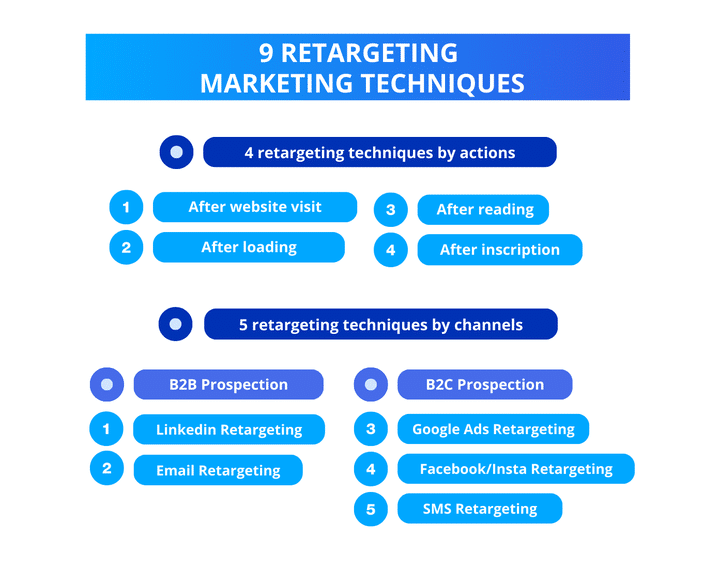
4 action-based retargeting techniques
➡️ We’ll start by detailing the 4 retargeting techniques for your prospects’ main (non) actions. 🤗
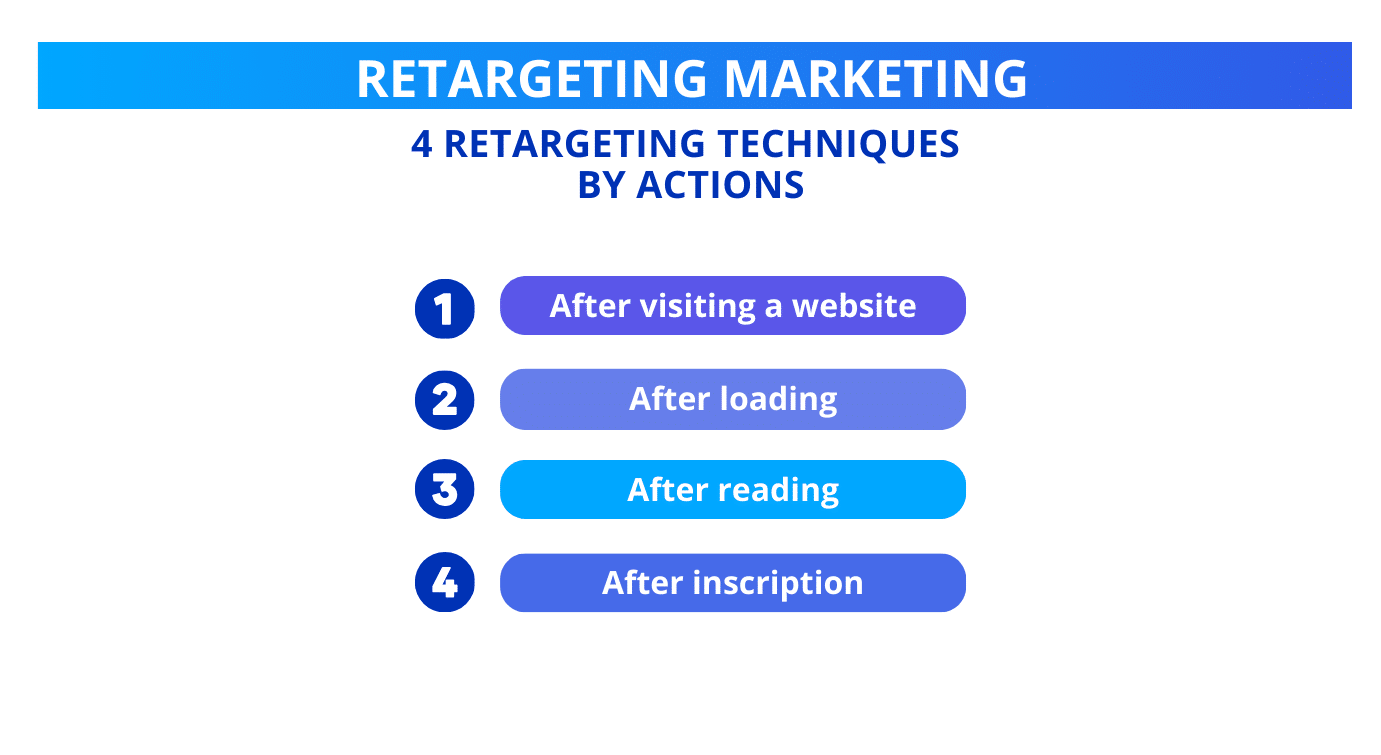
Retargeting after a website visit
ℹ️ This is the most classic retargeting technique, and also the first to appear. The definition of the term was therefore created from it.
As explained above, the aim of this technique is to “relaunch” after a website visit that didn’t result in any action. ❌
Most of the time, two types of non-action can lead to the use of this technique:
- Cart Abandonment 🛒: In this case, we’ll run ads showing what’s been left in the cart along with a special offer.
- Landing Page and Product Pages 👀: Here, we’ll display ads for recently viewed offers or content.
Best examples to follow:
🛍️ Amazon: Uses retargeting to remind interested parties of what they’ve viewed, often with complementary recommendations. Also, for abandoned shopping carts.
🛌 Booking.com: Targets web users who have consulted specific hotels with ads showing these establishments and other similar options.
Here are the different retargeting techniques that can be implemented in your ads to win back and convert:
- 📣 Product ads: If the user has viewed specific items, highlight these (or similar).
- 🤑 Special Offers: Use ads offering discounts, promotions or limited offers on consulted offers.
- 🛒 Cart Abandonment: Display ads showing abandoned items with reminders or special offers to complete the transaction.
- 📚 Related content to blog posts, guides, case studies…, to maintain interest and encourage further interaction.
- 🎨 Personalization based on browsing behavior. For example, if a surfer has spent time on a specific page, display reviews or testimonials relating to the page’s topic.
- 📲 Multi-Platform Campaigns: Deliver ads on various channels such as social networks (Facebook, Instagram Ads), search engines (Google Ads) and other partner websites to multiply contact points.
As for blog posts, e-books and webinars… They’ll be treated differently from the website 😉 We’ll tackle them together. 👇🏼
Retargeting after reading a blog post
When a blog post has been read without leading to the desired action, several retargeting techniques can be implemented in your ads:
- 🎁 Additional content offered to promote other articles or go deeper into the topic (successful videos, social networking profiles, etc.) to encourage readers to spend more time on your site.
- 📣 Of fer promotions: If the blog post mentions specific offers, use ads for them. Possibly offer discounts or promotions to entice readers to buy.
- 🔌 Resource downloads: Encourage readers to download resources (e-books, white papers, complementary guides…) in exchange for their information, generating qualified leads.
- 📩 Newsletter Subscription: Target occasional readers with ads inviting them to subscribe to your newsletter to receive regular updates, so they become regular readers.
- 🌟 Exclusivity: Target regular readers with ads or messages to offer them exclusivity (VIP and private groups, expert meet-ups, engagement pods, webinars and online events, free perks, etc.) related to the article’s topic.
Best examples to follow:
🟠 HubSpot: Targets readers of blog articles with ads for webinars or e-books related to the topic read, increasing qualified leads.
👨🏼🦲 Neil Patel: Uses retargeting to promote its consulting services to readers of specific digital marketing articles, maximizing qualified lead generation.
By using these retargeting techniques, you can turn your blog readers’ initial interest into concrete action. 🦾
Retargeting after e-book download
When someone downloads your e-book, that’s already a conversion! 👏🏼 So it’s safe to say you’ve done your upstream targeting job. 🏆
But, several retargeting techniques can be employed in your ads to continue to engage them and guide them towards more meaningful action 💸 :
- 🎁 Additional content related to the subject of the downloaded e-book, offered to maintain engagement.
- 🎉 Webinars and Events: Invite users to participate in webinars or other virtual events that delve deeper into the topic at hand.
- 🕹️ Product demonstrations or free consultations offered to those who have downloaded the e-book. Highlight the benefits and/or features of your offerings.
- 🤑 Special Offers and Discounts, time-limited discounts or promotions offered, to get them to buy or sign up.
- 📩 Automated Email Series: Set up a series of automated emails to provide additional information, case studies or testimonials related to the e-book topic.
Best examples to follow:
📖 LinkedIn Learning: After downloading an e-book, targeted ads are delivered to promote courses, webinars and free trials, turning initial interest into paid subscriptions.
☁️ Salesforce: Targets people who have downloaded e-books with invitations to demonstrations and case studies, showing how their solutions can solve specific problems.
Retargeting after viewing/subscribing (webinar or newsletter)
After a user has viewed, or signed up for, a webinar or newsletter ✅, several retargeting techniques can be used in your ads, to maintain engagement and encourage further action:
- ✍🏼 Relevant content: for example, ads about the webinar or newsletter.
- 🎉 Invitations to future events: target registrants with ads for upcoming webinars or similar events, or previous/future newsletters.
- 🌟 Exclusive benefits: After a webinar, offer demonstrations, free consultations or service trials, for your value proposition.
- 📩 Automated email series to provide additional information, case studies or testimonials, or to remind you to check your emails for more exclusives (new newsletter and webinar invitations).
- 🔄 Re-engagement :
- If a contact has registered but not attended a webinar, use ads to offer a recording of the webinar or invite to a future event.
- If a contact signed up for a newsletter, but didn’t open it, use ads to interact with them and reassess their interest.
The best examples to follow:
🔥 SEMrush: After registering for a webinar, SEMrush uses targeted ads to promote free trials of their tools, video tutorials and personalized consultations to convert leads into paying customers.
🐵 Mailchimp: After signing up for a newsletter, Mailchimp delivers personalized ads offering in-depth guides, additional webinars and free demos of premium features.
👆🏼 By employing these retargeting techniques, you’ll know how to respond to your users’ non-actions 😉
And, you’ll be able to continue to engage them and guide them towards further actions to maximize the conversion rate. 🤑
Top 6 retargeting techniques by channel
Now, we’ve decided to present you with 6 retargeting techniques for the main channels used to deliver ads to your prospects. 🤩
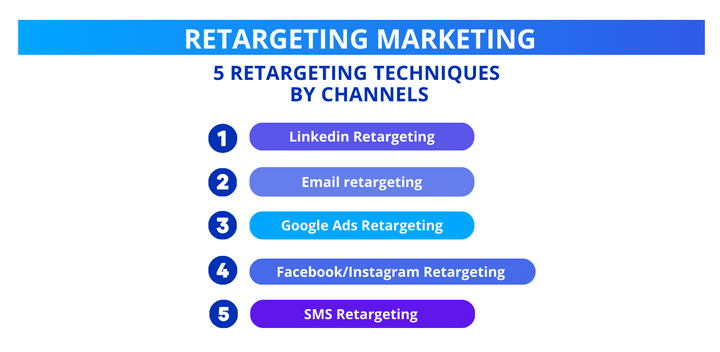
For B2B prospecting
🤝 Together, we detail retargeting techniques for your B2B prospecting, by channel. 💼
LinkedIn Retargeting
👤 LinkedIn can be used to retarget and redirect professionals who have visited your profile, liked or commented on your publications. But, also, for those who have shown an interest in your website.
Here’s how to retarget them 👇🏼 :
- 📣 Sponsored Content ads to use to appear directly in your targets’ news feed and encourage them to find out more.
- 📩 Sponsored InMail: Send personalized messages to create direct contact and encourage trust.
- 🎞️ Display Ads: Use display (banner ads) to target and encourage return visits to you or your site.
- 🦾 Lead Gen Forms: Integrate forms into your ads to generate leads. Interested parties will submit their information without leaving the platform, making it easier to capture qualified leads.
- 💥 Audience Expansion: an option for expanding the reach of your ads and reaching similar professionals.
The best examples to follow:
🎯 LinkedIn Marketing Solutions uses its own tools to retarget professionals who have visited their website with Sponsored Content and InMail ads, promoting case studies and free demos.
🟥 Adobe: Adobe uses display and Sponsored Content ads to retarget professionals who have downloaded e-books or attended webinars, offering free trials of their software and personalized consultations.
Email retargeting
Here’s how to retarget via email, which offers a direct and often more personal channel for encouraging desired actions. ⬇️ :
- 📏 Segmentation: Divide your contact list into segments based on past behavior (email opens, clicks or downloads) to create more targeted, relevant messages.
- 🎨 Personalization: Use behavioral data to personalize e-mails (product recommendations, relevant case studies, webinar invitations…), which are more engaging and increase conversion rate.
- 📩 E-mail Automation: Develop automated e-mail sequences to nurture leads over a period of time. For example, after downloading an e-book, send a series of e-mails providing additional information and case studies.
- 🛒 Abandoned Cart Reminders: For leads who have abandoned their cart/purchase, send cart reminders with incentives (discounts or special offers).
- 👩🏻💻 Invitations to webinars or online events for those who have shown interest in specific topics. Use post-webinar follow-ups to keep them engaged.
Best examples to follow:
🟠 HubSpot sends personalized e-mail sequences to people who have downloaded free resources, including case studies, testimonials and invitations to free demos.
🟥 Marketo uses these sequences to nurture B2B leads. After registering for a webinar, they send emails containing extras, invitations to free consultations and special offers.
Waalaxy, for retargeting and multichannel prospecting
👽 Waalaxy is a subscription-based Chrome extension for automating B2B multichannel prospecting campaigns, via LinkedIn and Email. 🤖
It presents itself as the simplest, most intuitive, secure and effective digital solution on the market! 🚀
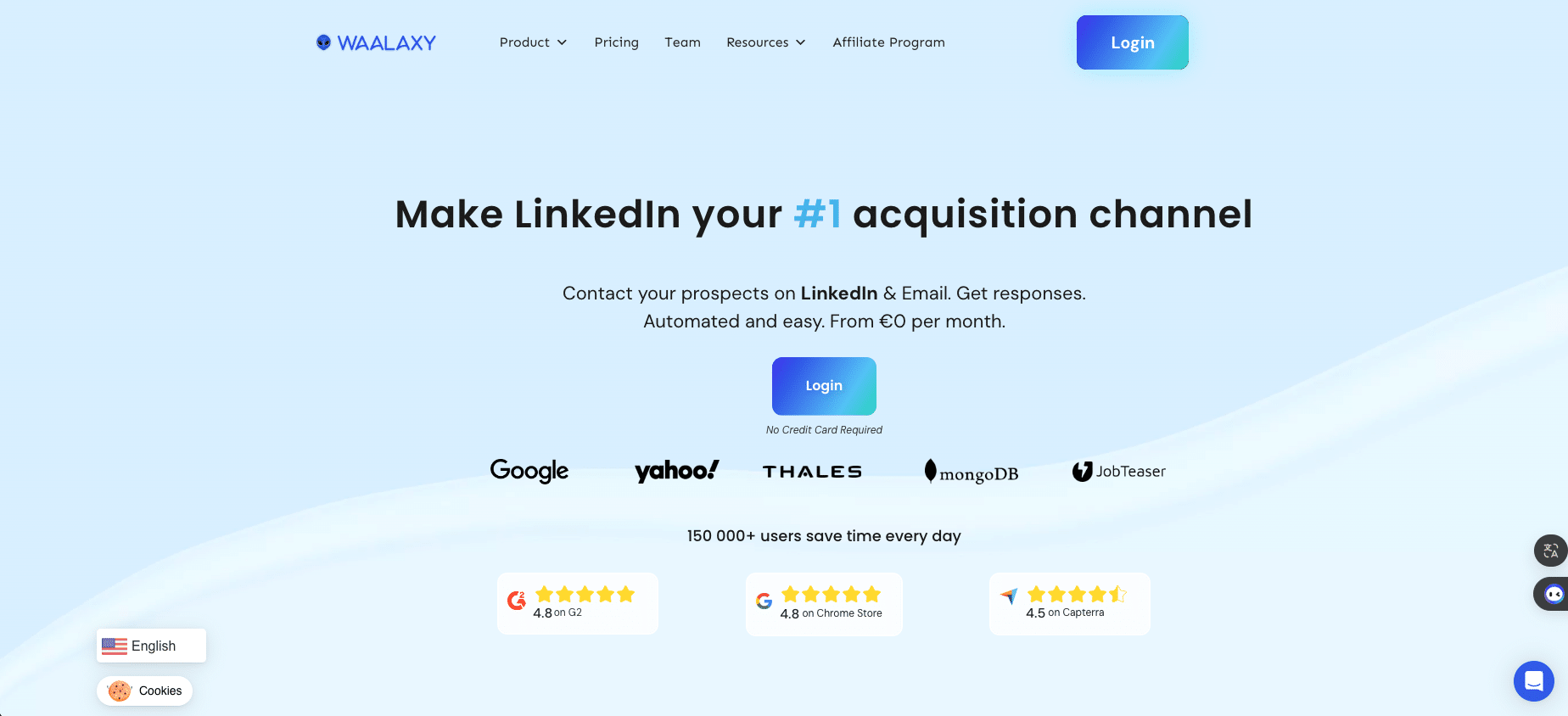
🤩 And, you can also use it to automate your retargeting! Here, what the tool lets you do 👇🏼 :
- Integrate third-party tools (numerous integrations on offer (HubSpot, Salesforce, NoCRM, Zoho, etc.). 🔗
- Import data from contacts who have interacted with your previous campaigns, social networks or website into Waalaxy.
- Generate a prospecting database by automatically retrieving :
- Contacts of people who consult your LinkedIn profile or interact with your posts.
- Their email address, so you can launch a multichannel campaign.
- 📩 Enrich your lists with similar profiles, spotted on LinkedIn, thanks to Waalaxy’s AI-powered Prospect Finder (fully RGPD). 🔒
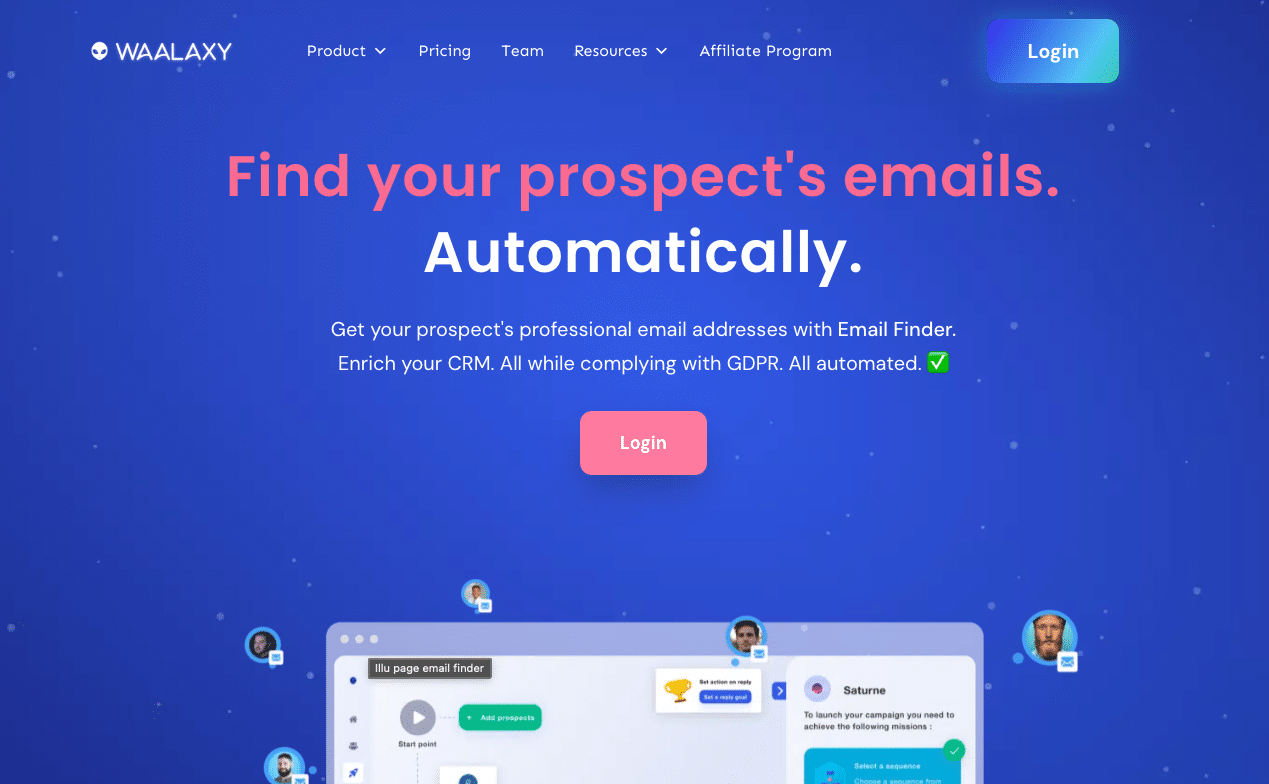
- Cleanse the database, then form lead lists to segment your targets. 🎯
- 🤖 Add one or more lists and configure automated message sequences (from the template library) to engage identified profiles.
- Write and optimize your personalized message(s) to re-engage your leads ✍🏼. In particular, thanks to variables, attachments, clickable links, images, voice notes, AI assistant, etc).
- Then launch the campaign to effectively convert them into qualified leads… without spam or disappointing open rates! 🚀
Examples of the best retargeting campaigns on Waalaxy:
1️⃣ Re-engage people who have downloaded an e-book. 👉🏼 Use Waalaxy to send personalized messages with case studies and webinar invitations related to the e-book topic.
2️⃣ Convert LinkedIn profile views into qualified leads. 👉🏼 Set up a sequence of automated messages to say thank you, offer a free consultation and follow up with relevant testimonials.
Finally 🍒:
- All you have to do is watch the tool work for you and monitor performance from the Waalaxy dashboard. 📊
- Waalaxy offers you foolproof support with a galaxy of resources to help you achieve all your goals. 🤯
👇🏼 You really can’t miss this! 🤩
💥 Your prospecting, generation, acquisition and retargeting strategies… are about to become unstoppable thanks to Waalaxy! The tool still has a few trump cards up its sleeve that could serve the effectiveness of your campaigns 😉
For B2C prospecting
🤝 We’re not B2C specialists, but we can give you a few tips on specialized retargeting techniques by channel (via Google Ads, Meta tools, SMS and Display ad). 🫂
✨ Here are some tips for retargeting and reaching a wide audience through various types of online content 🤩, applicable across all the channels mentioned:
- Customer Lists ☑️: Harvest information from your customers when they’re logged in, or download existing lists to create personalized audiences and deliver targeted messages.
- Standard Remarketing 🏹: Display ads to people who have visited your website or app without converting, and target specific segments (product pages, cart abandonment, etc).
- Dynamic Remarketing 🤸🏼♂️: Show personalized offers with dynamic ads, based on behavior on your site.
- Video Remarketing 📲: Use YouTube to broadcast to people who have interacted with your site or channel, or who have viewed part of your videos (highlight promotions or related offers).
- Remarketing by Category 🏷️ explored. For example, if a visitor has visited several women’s clothing pages, display only items from that category.
- Promotions and Exclusive Offers 🎁 : Target potential customers or recent visitors, and offer special limited-time offers, discount codes, flash sales…
- Inactivity 📵: Broadcast ads specially designed to re-engage inactive customers (with special offers or reminders to encourage them to return to your site).
Obviously, there are other techniques that we haven’t presented above, as they aren’t applicable to every marketing channel. We’ll give you a few pointers, and cover them briefly: 👇🏼
Google ADS retargeting
Retargeting with Google Ads lets you re-engage lost prospects by targeting them with personalized ads as they browse the web.
This strategy involves showing targeted ads to users who have previously interacted with your website or app but haven’t yet completed a conversion (like making a purchase or signing up).
For example, if someone visited your product page but didn’t make a purchase, you can show them ads for that product while they’re on other sites, reminding them of their initial interest.👀
👉🏼 How does it work?
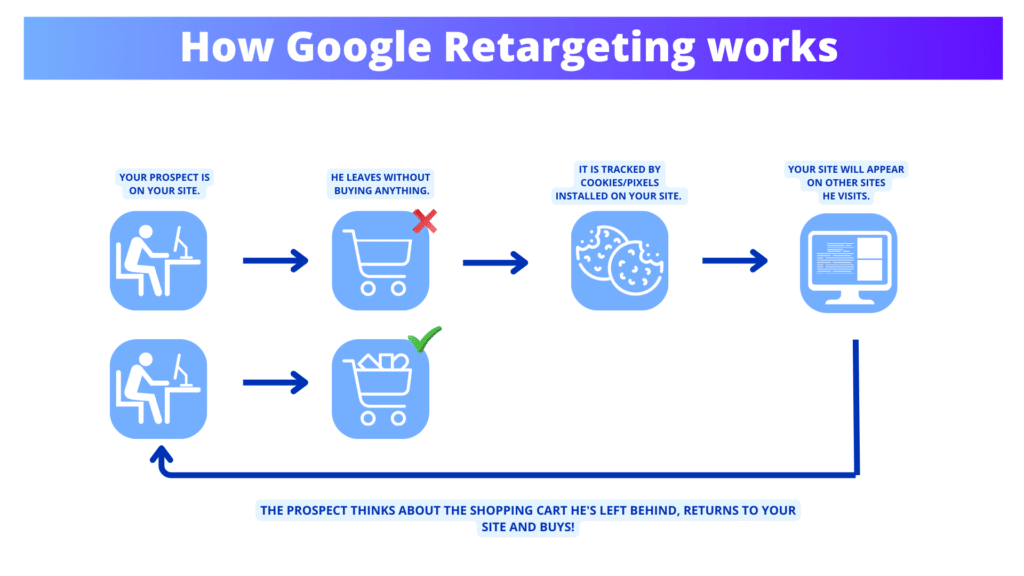
Its advantages ✅:
- Cost-effectiveness: Target users who have already shown interest in your brand, which can be more cost-effective than finding new prospects. ✨
- Personalization: Display relevant ads based on users’ previous actions. 👤
- Increased conversions: Stay top-of-mind with your prospects, increasing the chances they’ll return to your site to complete an action. 🛒
👉🏼 Which Google campaign should you choose: Search or Display?
Search ➡️ Ads appear in Google search results when users search for keywords related to your product. This is ideal for capturing the attention of users at the exact moment they’re actively showing interest in your offer. ✨
Display ➡️ What’s fascinating about display is that ads are served on the Google Display Network, which includes millions of partner websites and mobile apps. These ads can be banners, images, or videos. They help keep your brand visible while your prospects are browsing other sites. 😯
👉🏼 Examples to follow: 🎧 Spotify for its new releases or personalized music suggestions, and 🌼 Wayfair for reminders of consulted offers or special promotions.
Google Ads ➡️ with RLSA search network remarketing (bids and ads tailored to users’ past behavior). 👩🏻⚖️
👉🏼 Examples to follow: 🛍️ Amazon for dynamic retargeting and 👟 Nike for using RLSA.
Facebook & Instagram retargeting
➡️ Instagram and Facebook, with :
- Retargeting stories 🤳🏼 (include direct promos and/or CTAs),
- 👀 Lookalike Audiences (to reach similar profiles from your lists or visitors).
Instagram and Facebook are treated together, as since their entry into the Meta group, they have mostly the same features in terms of advertising. 👉🏼 Examples to follow: 🔑 Airbnb and 👗 ASOS.
SMS retargeting
➡️ Old school 🪩, but still just as effective, SMS marketing is to be used in the following cases 💬 :
- Cart abandonment,
- Reminders of events related to content consumed and/or preferences,
- Replenishment notifications on items of interest,
- Post-purchase follow-up (to recommend a product or give feedback…).
👉🏼 Examples to follow: 💄 Sephora for basket reminders or discount offers, and 🍕 Domino’s only for promos.
Of course, the choice of channels for delivering your ads, as well as the tools used, depend entirely on your audience, your business and your mastery of retargeting. ⚙️
Best practices for getting started with retargeting
💎In short, whatever the actions involved and the channels chosen for your strategy, here are some final recommendations for success in retargeting:
1. Segment 📏: Identify different unique visitors groups (based on actions taken or not taken). This allows you to create more relevant and targeted messages.
2. Personalize ads 🎨 and use messages/visuals tailored to each segment, which will encourage more engagement and improve customer relationship.
3. Ensure message consistency 💬, with your site and overall user experience (ideally fluid and seamless to reinforce your brand’s credibility).
4. Use time-limited incentive offers 🎁 (promotions, discounts, events…) to create a sense of urgency and encourage users to return and convert.
5. Limit frequency: Avoid bombarding too many ads at once, as this can irritate the target and damage your brand’s image. ❌ In particular, by defining a broadcast frequency and also by alternating the types of ads sent, depending on the actions not carried out.
6. Test and optimize 🧪 : Set up A/B tests for different elements of your ads (titles, images, calls to action) and to identify what works best before sending.
7. Analyze performance 🔎 (click-through rates, conversions, ROI…), then, analyze the results to adjust accordingly.
We advise you to use these best practices as a roadmap, to follow for successful retargeting campaigns (B2B and B2C)! 🏆
Conclusion
💔 Sadly, that’s the end of this article, with which we’ve seen how to include retargeting in your marketing strategy and why. 🧐
💡 To sum up, with all the techniques detailed and using all the best practices mentioned above, you’ll be able to 👇🏼 :
- Adapt your retargeting strategy
- Maximize the effectiveness of your campaigns,
- Effectively re-engage interested parties,
- Turn them into qualified leads,
- Personalize advertising experiences,
- Increase and exploit conversion opportunities,
- Optimize your return on investment.
- And improve customer loyalty.
🚀 Now you’re ready to optimize your marketing efforts, recover all those lost opportunities and turn initial interest into concrete action. 🤑
Frequently Asked Questions (FAQ)
🏁 To conclude, here are the answers to the most frequently asked questions on the subject. 👇🏼
What’s the difference between Retargeting and Remarketing?
The terms retargeting and remarketing are often used interchangeably 🔄. Yet, they differ in the ways they are used to strengthenin customer relationships. 🤝
➡️ As explained in this article, retargeting focuses primarily on the use of paid ads to target unique visitors who have interacted without converting, notably by using cookies to track their online behavior.
➡️ In contrast, remarketing (often associated with e-mail) involves re-engaging existing customers by sending them personalized messages based on their past interactions with the brand.
How much does retargeting cost?
💰 It’s always tricky to estimate a budget, without having a precise idea of the company and its activity… Because, of course, the cost of retargeting varies according to several factors:
- The platform used,
- Audience size
- competition,
- Your objectives,
- Campaign duration…
In general, the acquisition cost per click (CPC) 🖱️ is between $0.25 and $1.50, but can be higher in competitive sectors.🦾
👉🏼 For example, an SME can spend between $500 and $1,500/month, while a large group can invest thousands of euros for more extensive, targeted campaigns.
How to choose the right retargeting tool?
To choose the right retargeting tool, there are obviously several criteria to consider.
- Evaluate the features offered, such as cross-platform retargeting, ad personalization and segmentation options.
- Check integration with your existing systems (E-commerce and CRM tools).
- Compare costs according to your budget and specific needs.
- Examine reporting and analysis capabilities to measure the effectiveness of your messages.
- Finally, read user reviews and case studies to assess the tool’s reputation and reliability.
💡 Our advice is to choose a solution that aligns with your marketing objectives and can grow with your business. 🪄
Now you know all about regargeting, no more conversion opportunities will escape you. 😉 See you soon! 👽









